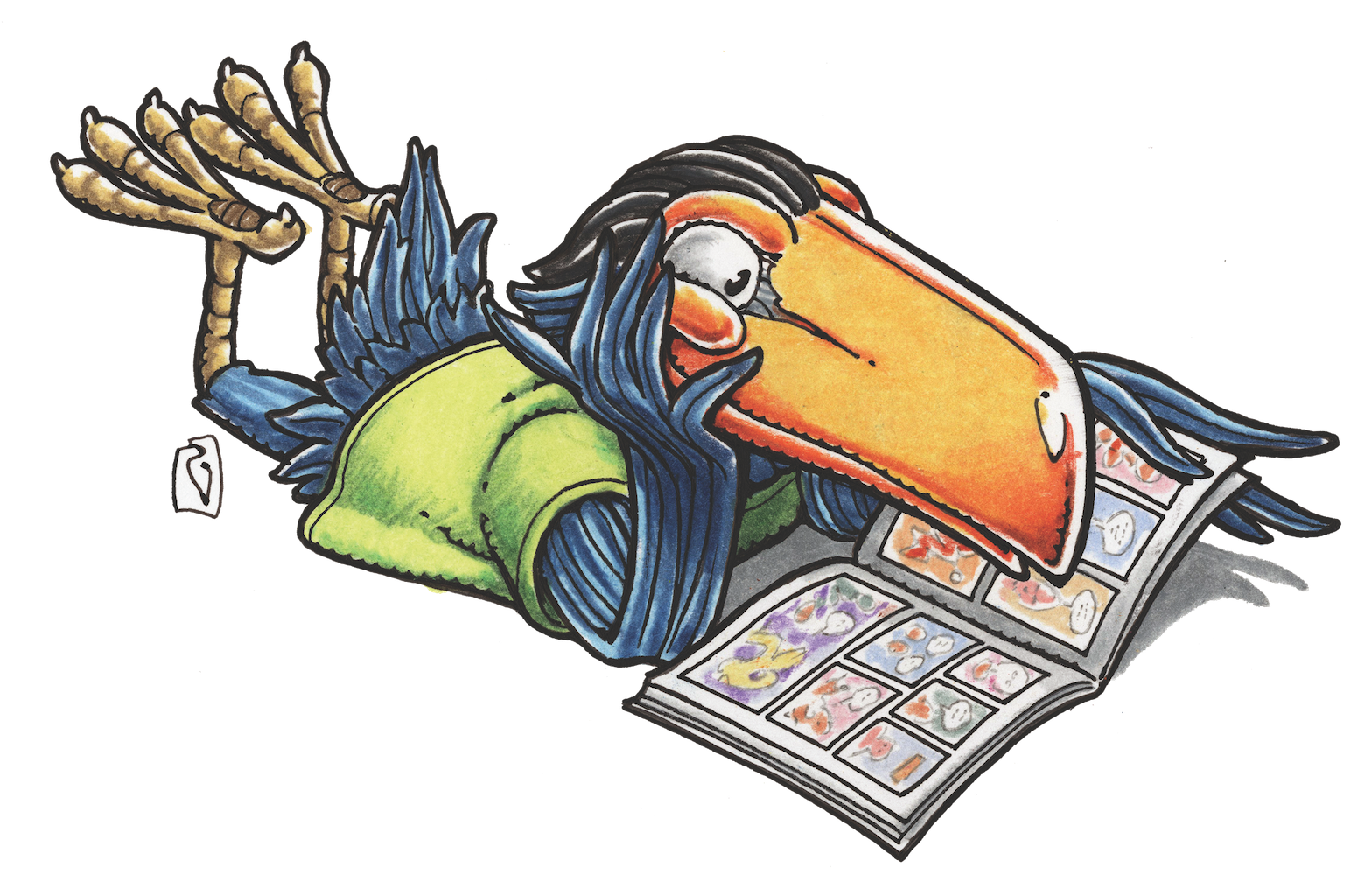DILETTANTE BY STEVE LIEBER
Dilettante 052: The Takeaway


This is my 52nd “Dilettante” column for Comic Con’s Toucan Blog, and I’m sorry to say it’ll be my last. I’ve had a terrific time writing for you, but the time has come for me to pass this space along to another writer.
Throughout my time here, I’ve discussed what I’ve learned about the art, the craft, and the business of making comics. For this final column, I thought it might be worthwhile to try to identify the most important lessons I shared here. What’s the takeaway?
1. Stay focused on story
Every comics page offers challenges and opportunities. You’re asked to draw people, places, clothing, gestures, props, situations. You design typography and compositions, and you get to arrange the panels to create new meanings by how they relate to each other. It’s fun, but it can seem like an endless parade of exhausting choices. When there are so many options and possibilities, how do you choose?
The answer is to serve the story. The layout that best serves the story might not always be the most fun to draw, or the most glamorous moment, or the most impressive bit of draftsmanship. Stories sometimes need simple, quiet, or prosaic moments. Other moments might require you to knuckle down and draw something really tough. One story might need dramatic, high-contrast lighting, with vivid bright areas, and deep shadows. Others might call for the austerity of clean, uninflected outlines. A coming-of-age memoir that turns on a specific detail of period fashion will require you to draw in a way that makes that fashion recognizable. Another memoir might work best with wild expressionism that deemphasizes naturalistic observation and prioritizes emotional intensity.
Know your story inside and out, and let it guide your choices.
2. Use the tools you need
It’s so easy for cartoonists to make a fetish of tools. Sometimes a young artist hears that her favorite artist only uses a certain brand of brush, and decides that she’s going to use one, too, regardless of whether it gives her the lines she wants. Or he hears classmates at art school call photo-reference “cheating” and so he puts aside a valuable tool that could improve his results and save him hours of work. It took me a long time to learn this: art is not sports. There’s no regulatory body that’s enforcing league rules about what equipment you’re allowed to use, or how you’re allowed to use it. All that matters is what’s on the page, not the difficulty of putting it there.
3. Read your contract and get a lawyer
Making comics in any sort of professional capacity is running a business. You’ll be providing services to or partnering with publishers, signing agreements with distributors, suppliers or licensors, hiring subcontractors or being hired. It’s complex stuff. A sentence in a contract can be the difference between an arrangement that goes smoothly and one that you regret for years. A contract is an agreement between two or more parties. Ideally everyone will understand exactly what they’re agreeing to. Hire a lawyer who has a good grasp of what you’re doing. If you can’t afford a lawyer, see if the Volunteer Lawyers for the Arts are active in your area.
4. Put your work in front of people
Don’t be shy about showing your work. If you want to be published, you’ll want to be seen by editors, agents and art directors. If you want to support your work via crowdfunding, you’re going to need a crowd. Do good work, do a lot of it, and use every means available to put that work in front of people who might pay you for it. This might mean going to conventions. It might mean samples through the mail. It ‘ll definitely mean using social media. Go get on Twitter, Instagram, Tumblr, Facebook, or wherever people are congregating. If possible, maintain a consistent user name across the various platforms. Put your work out there for people to see. Engage with them too; treat those people in your chosen platforms as people. Get into conversations, be a human being. It’s called social media. Be sociable!
5. Comics is a marathon, not a sprint
Don’t get frustrated. For most cartoonists it can take a while to get good, to get hired, to get published, to get a supportive audience. You’ll have ups and downs creatively, financially, emotionally. Don’t let the stories you hear about overnight successes discourage you. Plenty of artists take years to find their footing. Some artists keep a day job their entire life, and do all their comics in spare time and on weekends. There is absolutely no shame in that.
And it can take a long time to find your voice as well. I’d been drawing professionally for seven years before I put out a comic I felt good about. It’s been 20 years since then and I still have moments when I can’t make a drawing do what I want. I can cope with that because I’m not here to make one perfect drawing. I’m here to tell stories, and if one page doesn’t quite work, I’ll apply what I learned to the next one. I want to keep making comics for the rest of my life so I know I’ve got plenty of time to learn.
6. Ask for help
If you’re struggling with a tech problem, there’s a really good chance that someone else has already solved it. Ask around in person, or on social media. Not sure if the point of a panel is clear? Ask someone who doesn’t know the story to interpret the panel and see if they understood your drawing. If you can’t quite get a gesture right, ask a friend to pose for reference and snap a couple of photos. If there’s a prop you need to draw from, see if someone you know already owns one. Cartoonists have a bad habit of becoming hermits and trying to do everything themselves. But you know what? People want to help you. You’ll be both more productive and happier if you let them.
7. Help others and build community
You probably already know a lot. You know people, you know the books you’ve read, the movies you’ve seen, and the artists you admire. You’ve fought with software and hardware and printers and scanners, tried various pens and paints and brushes. You can pose for someone’s reference photo, read someone’s first draft, brainstorm about a book release party, help set up chairs for a reading or a panel. Boost someone’s tweet or article. Spread the word about an impressive new book, or an exciting reissue.
The world of comics is built on small supportive, interlocking communities, both face-to-face and virtual. I’ve gotten where I am in comics because of the help and support I’ve received from teachers, mentors, peers, editors, retailers, festival organizers, journalists, critics, and readers. And I’ve been fortunate enough to take on most of these roles myself, too. My time as a teacher and mentor has been every bit as rewarding as the time I spend at the drawing board. Being part of comics can bring you close to a whole community of wonderful, funny, thoughtful people. They’re friends, peers, protegés, sometimes even family. Share your time, your effort, and your expertise, and you’ll find you get back what you give.
I’d like to say thank you to everyone who has followed this column, and especially Gary Sassaman, who brought me aboard and made it all happen. And if you have any thoughts to share about comics, talk to me! On Twitter I’m @steve_lieber and on Facebook I’m at https://www.facebook.com/steve.lieber
(Editor’s Note: We’re very sad to see Steve leave the Toucan family. He was the first regular contributor we recruited back in early 2012, when we were planning to add a blog to our website, and he’s provided five years-worth of incredible columns (you can read them all here) filled with valuable information for any artist, from new and budding to seasoned professional.
Who will take over the second Tuesday of the month slot here on Toucan? Well, we’re working on it. Tune in next month to see who takes on the mantle of our monthly artist columnist!)